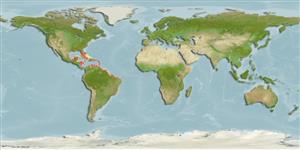Environment: milieu / climate zone / depth range / distribution range
Ecologie
marien; brak water rifbewoner; oceanodroom; diepte 0 - 5 m (Ref. 5227). Subtropical; 45°N - 40°S, 98°W - 32°W
Western Atlantic: south Florida (USA), through the Caribbean and along the coasts of Central and South America to Uruguay.
Lengte bij maturiteit / Grootte / Gewicht / Leeftijd
Maturity: Lm 18.9 range ? - ? cm
Max length : 30.0 cm TL mannelijk / geslacht onbekend; (Ref. 5217); common length : 20.0 cm SL mannelijk / geslacht onbekend; (Ref. 3723)
Body elongate; lower jaw very prolonged; upper jaw short, triangular, and scaly; lower branch of first gill arch with 29 to 38 gill rakers; fins lacking spines; pectoral fins not very long; caudal fin emarginate or slightly forked; anal fin with 15 to 18 rays; back greenish, with 3 narrow, dark, bars; flanks and belly silvery white; fleshy border of lower jaw red; caudal fin light colored with dark tips (Ref. 55763).
An inshore, surface-dwelling species forming sizeable schools, frequently entering estuaries (Ref. 3723). Uncommon over reefs (Ref. 9710). Omnivorous, feeds on algae and other small animals (Ref. 3723). Caught with 'mandinga' nets in Venezuela, often using lights (Ref. 3723). Edible but not really appreciated (Ref. 3723).
Levenscyclus en paargedrag
Maturiteit | Voortplanting | Paaien | Eieren | Fecunditeit | Larven
Robins, C.R. and G.C. Ray, 1986. A field guide to Atlantic coast fishes of North America. Houghton Mifflin Company, Boston, U.S.A. 354 p. (Ref. 7251)
Status op de Rode Lijst van het IUCN (Ref. 130435: Version 2024-1)
Gevaar voor de mens
Reports of ciguatera poisoning (Ref. 30911)
Gebruik door de mens
Visserij: van minder commercieel belang; aas: usually
Tools
Speciale rapporten
Download XML
Internetbronnen
Estimates based on models
Preferred temperature (Ref.
123201): 22.9 - 28.1, mean 27.3 °C (based on 769 cells).
Fylogenetische diversiteitsindex (Ref.
82804): PD
50 = 0.5000 [Uniqueness, from 0.5 = low to 2.0 = high].
Bayesian length-weight: a=0.00234 (0.00180 - 0.00305), b=3.09 (3.03 - 3.15), in cm total length, based on LWR estimates for this species (Ref.
93245).
Trofisch niveau (Ref.
69278): 2.0 ±0.0 se; based on diet studies.
Generation time: 0.8 ( na - na) years. Estimated as median ln(3)/K based on 1
growth studies.
Weerstandsvermogen (Ref.
120179): Hoog, minimale populatieverdubbelingstijd minder dan 15 maanden (Preliminary K or Fecundity.).
Fishing Vulnerability (Ref.
59153): Low vulnerability (15 of 100).
Nutrients (Ref.
124155): Calcium = 234 [47, 570] mg/100g; Iron = 1.01 [0.31, 3.13] mg/100g; Protein = 18.9 [15.8, 21.3] %; Omega3 = 0.156 [0.056, 0.474] g/100g; Selenium = 13.1 [4.2, 47.4] μg/100g; VitaminA = 47.8 [8.0, 301.1] μg/100g; Zinc = 1.65 [0.61, 4.77] mg/100g (wet weight);
